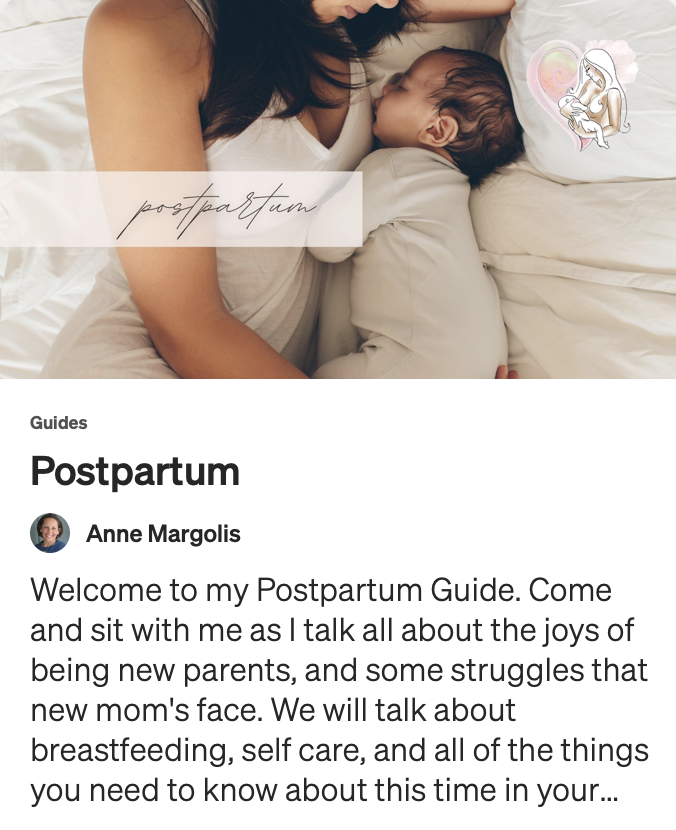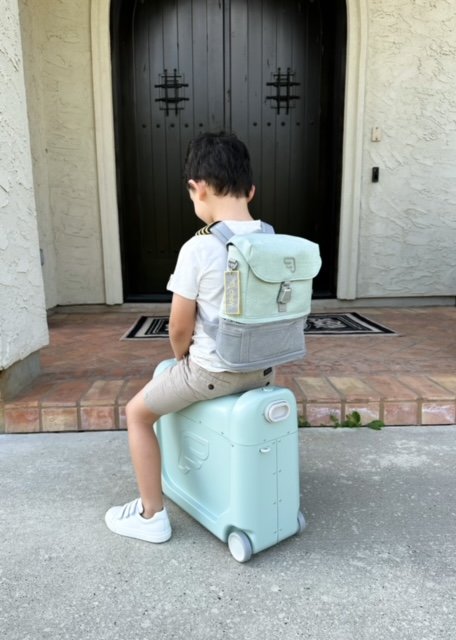POSTPARTUM CARE AT HOME: YOUR COMPREHENSIVE GUIDE TO THE FIRST FEW WEEKS - PART TWO
Do see last month’s blog for Postpartum Care at Home: Your Comprehensive Guide to the First Few Weeks - Part One.
Dealing With Postpartum Exhaustion
Welcome to motherhood! Caring for a newborn and recovering from childbirth is no small task. Fatigue can easily lead to exhaustion, infection, irritability and depression if you do not listen to your body’s signals for increased rest during this time.
The best way to minimize fatigue is to spend the first two to four weeks after birth (longer after cesarean) caring only for yourself and your baby, while someone else (like your partner, a close relative or friend) tends to the other needs of the household. No need to feel guilty for doing nothing other than resting, taking care of you and your baby during this time. This is your sole job right now, with nothing else on your plate.
Many of the suggestions for fatigue in pregnancy still apply, but other suggestions specific for postpartum to prevent exhaustion include:
Eat well, at least three whole food varied healthy meals and snacks, without skipping meals
Drink at least 8-10 glasses (64 ounces) of water daily
Take recommended supplements, to ensure you are getting all the nourishment not you need for yourself and your baby while you breastfeed and recover, that is not supplied by diet alone.
If you are anemic or had excessive blood loss after birth, be sure to take herbal iron at least for the first 6-8 weeks postpartum, until you feel back to yourself and your labs including iron stores are normal.
Try to plan so that for the next 2, ideally 4 weeks, someone other than you is doing errands, cleaning, preparing meals for you and your family, and tending to the older siblings.
Consider hired help (such as a mother’s helper or postpartum doula, a cleaning lady and even a personal chef or healthy meal delivery) if you do not feel you have enough support, or after your support leaves. This can be put on your online baby gift registry and is much more essential than stuffed animals, toys and an oversupply of newborn clothes Baby will soon grow out of.
Be honest and direct about communicating your needs. Don’t be afraid to delegate responsibilities to others.
Gratefully accept offers to help. Remember this is not just a much needed time to heal from the birth, but it is also a sacred time to get to know your baby and learn to breastfeed. As long as you are well supported, allow yourself to enjoy this special time and bask in the loving support of others.
Rest, sleep and lounge as much as possible during at least the first month postpartum. Nap when Baby naps and ask a friend or relative to take the older kids for even an hour or two each day so you can do this. When you have a choice between folding the laundry or doing the dishes and napping, choose napping. Do not give into the temptation to do any housework, errands, childcare or cooking, as these tasks can be delegated to others during this time while you are recuperating. This is not a time to be supermom. Allowing yourself this extra time to rest now, will help you stay well physically and emotionally for you and your family, and will help you feel back to yourself sooner.
Be strict with visitors. Don’t be shy about suggesting when it’s best for them to visit or excusing yourself if you feel tired. Ideally, put a sign on your front door saying something like,
“New moms and babies need lots of rest and help. We are resting now, please do not disturb. But, we would love a short quiet visit between {insert baby’s most awake hours}. If you would like to stay longer, please bring or cook a meal, play with our older children, or do some housework like the dishes or laundry.”
Ask your partner to tend to the baby at night after you breastfeed for burping, diaper changing, settling, or holding skin to skin. Once breastfeeding is well established, your partner can also give the baby a bottle of expressed breast milk for one of the night feedings.
Keep night feedings dark, quiet and boring so that baby will eventually learn to sleep longer periods of time during the night.
If you can’t fall asleep at night, try these suggestions for insomnia, and make sure to take 1-2 daily naps or rest periods when the baby sleeps. Remember to silence your phone. Better yet, keep it out of the bedroom.
Limit caffeine and avoid it after 4:00 P.M.
Limit time on computer and iphone, and avoid it after dark.
Get daily fresh air and sun exposure during the non-peak hours.
Treat yourself to a nice deep tissue massage focused especially on areas of aching muscles, or ask your partner to do it. A soothing simple combination for massage oil includes 3½ ounces Almond oil, ½ ounce Arnica oil, 15-30 drops of your favorite uplifting essential oils like Rosemary, Evergreen (Pine), Peppermint, Spearmint, Rose, Geranium, Ylang Ylang, Orange, Lemon, Citrus blend, Lavender or Jasmine. Shake well before each use, and store in a cool dark place in a glass bottle (this Almond oil comes with an extra 4 ounce travel bottle). A few drops of Vitamin E oil can be added to preserve it.
After the first few weeks, an occasional weekend in a nice hotel with your partner and baby can be a really nice restorative rest and treat. And so worth the expense, as the hotel staff will clean your room and cook your meals!
Practice regular yoga and light stretching any time. There are many ways to do it with your baby, or you may benefit more from having some space to do it alone, leaving Baby with pumped breast milk and a trusted sitter. Gradually get back into exercise in the morning or early afternoon after the first several weeks, and increase as tolerated after your bleeding stops and you feel up to it.
Do daily 10-20 minutes of conscious connected breathwork that provides you with natural energy and increases vitality.
Heed to signs of not getting enough rest, which include:
Ongoing exhaustion
Feeling run down and achy
Excess or prolonged bleeding
Inflamed clogged milk ducts
Frequent infections and colds
Excess emotional irritability
Report to your practitioner if you cannot sleep, are too exhausted to cope, or your fatigue worsens or does not ease up by six weeks after Baby is born.
Excessive Sweating, Peeing and Shaking
A normal increase in perspiration and trips to the bathroom are common as your body rids itself of additional fluids that developed during pregnancy, and IV fluids if given during labor. Intense shaking right after birth is also common due to the hormonal fluctuations, temperature and body changes after the huge work your body just did to give birth. This is a normal stress response to release the intense energy that was involved.
Suggestions are:
Ask your partner to hold you when shaking, but do encourage and embrace the shakes, without trying to stop your body from doing what it needs to do in order to reset.
Take Rescue Remedy to support your normal stress response, if you feel you need it.
If you are cold, wear absorbent all-cotton clothing and warm socks, dress in layers and cover yourself with warm blankets.
For sweating and chills not related to infection:
Sleep on a large towel or terry cloth sheets.
Drink Ginger tea alternating with Cinnamon tea. It is best homemade, by adding a pinch of freshly ground ginger or a stick of Cinnamon to 1 cup boiling water and brewing covered for 15-20 minutes. Or a steep a stick of cinnamon in the water for a few minutes. Strain into a glass mason jar, add honey and or pure nut milk to taste.
For severe sweating, get an acupuncture treatment to balance your Qi and promote healing.
Report to your practitioner persistent sweating that lasts several weeks, chills, muscle aches, and temperature over 100.4 after the first few days.
Dealing with Feeling Fat
This is one of the most common postpartum complaints. Women often struggle with body image issues postpartum, and feel fat. Typically, only about 12 pounds are lost with delivery, another 5 pounds are lost during the first week, and an additional few pounds are lost by the 6 week check-up. It can take several months for the fat stored around your hips and buttocks for breastfeeding and nourishing you during the pregnancy and postpartum, to be used up. So, it is good to remember that the calories used for breastfeeding will help you lose this extra pregnancy weight.
The rest of the weight gained during pregnancy will have to be lost through a healthful diet and exercise program. Also, it takes at least 6 weeks for the uterus to return to a non-pregnant size, and it takes time and abdominal exercises to tone up the muscles and overlying skin that was stretched. It takes at least several months to return to your pre-pregnant size.
Remember, breast milk production requires even greater caloric intake than pregnancy, as you are the primary provider of nourishment to your rapidly growing baby. So, this is definitely not an appropriate time to diet, as it deprives you and your baby of essential nutrients. If you gained excessive weight in pregnancy or were overweight before pregnancy, eating varied, whole food of high quality, and avoiding processed foods high in unhealthy fats, refined carbohydrates and sugars, and regular exercise when ready, is usually sufficient.
To summarize:
Drink 64 ounces filtered, spring or well water daily between meals, at least 20-30 minutes before or 2 hours after eating.
Eat a balanced, nourishing and varied diet high in:
Fresh organic fruit and vegetables
Organic tofu and tempeh
Beans
Nuts, nut butters, and seeds
Organic pastured whole eggs
Organic free range, grass fed chicken and turkey, beef, lamb, and wild game
Wild Alaskan salmon and other fresh water fish from non polluted waters
Organic whole raw dairy-goat or sheep is best
Limited whole grains (sprouted is ideal)
Organic cold expeller pressed extra virgin olive oil, coconut oil, ghee or goat butter
Avoid foods that are heavily processed and loaded with unhealthy refined vegetable oils and partially hydrogenated fat, sugars, refined flours and starches.
Begin regular exercise like brisk walking or dancing as soon as you are able and the bleeding stops. Aim for 30 minutes 4-5 times per week. Pilates is a great way to strengthen your muscles, and especially tone up your core. Yoga will tone your core as well, in addition to increasing total body flexibility and strength, and helping you calm and grounding feelings. Ideally, take a local class like mommy and me yoga or postpartum yoga and Pilates. There are also plenty of online classes until you can manage to get out to an actual class. Light walking, gentle yoga stretching, side lying leg lifts, pelvic floor muscle strengthening, and gentle abdominal toning exercises can be done after the first few weeks. Gradually increase time and intensity as you are able. Listen to your body, though. There is no need to rush or push yourself during this time of needed rest, healing and recovery.
Historically and in plenty of cultures around the world, a fuller figure is more glorified, respected and honored, and being too thin is not considered healthy or attractive. While obesity is unhealthy and it is important to have a healthy weight and body image, there are many variations in normal weight and body characteristics. Ditch the pervasive media pictures of thin models. They are not realistic, they wreck havoc with body image and often result in you feeling unnecessarily bad about yourself. If you need to, look at the #BodyPositive images of mothers on social media. Be mindful of unhealthy thoughts from modern, western cultural stereotypes that imply “thin is most beautiful” and “looking fat is ugly.” Try to replace them with more true affirmations of pride and gratitude for your body having just grown and birthed your baby. Maintain acceptance and love for your unique body type which is forever changing. Know that you are more than just a body, but a beautiful eternal soul with your own special gifts, attributes and purpose far bigger than that of your body. Even though you are a postpartum woman who has just birthed her baby, you are also physically radiant, lovely, magnificent and have a deeper sort of beauty and wisdom.
Postpartum Depression and Anxiety
Intense emotions, mild depression, anxiety and mood swings are common in the first few weeks after having a baby, as are postpartum struggles. This is especially true if you are overtired and exhausted, without help or support from others, and/or have other stresses, personal issues or other problems. You may find that you are at times down, irritable, easily upset, extremely sensitive, cry without apparent reason, overwhelmed, tense, anxious, and unable to concentrate or remember things.
Natural remedies to lessen the emotional ups and downs, and help you cope include many that are mentioned in my posts for managing stress and emotions in pregnancy.
Suggestions specific for postpartum include:
Minimize fatigue with the tips from the exhaustion section above. A - adequate sleep is crucial.
Eat a healthy well-balanced diet as described above, but many feel best completely off gluten, dairy, soy and all forms of cane sugar. Consider eating an organic Paleo diet, an ancestral whole or real food way of eating high in pastured organic animal protein and healthy fat, plenty of fruits, veggies, nuts and seeds, with free use of herbs, spices and healthier sugars like raw honey. Try it for a month. You will be amazed how much better you feel physically and emotionally.
For general health and physical and emotional well-being, make sure to take the supplements here that include a whole food multivitamin, omega threes, probiotics, Vitamin D, plus those specific for symptoms of anxiety and depression:
Calcium, 250-500mg 2-3 times daily
Magnesium, 200-400mg 2-3 times daily
Vitamin B complex, 20-50 mg once daily with methylated folate and
Vitamin B12 sublingual (under the tongue) in the form of methyl, hydroxo or adenosyl cobalamin), 1000-5000 mcg daily to 2-3 times weekly depending on symptom severity and blood levels
Curumin (Tumeric), 500 1-3 times daily to reduce inflammation linked to depression, anxiety and other mental health challenges
Evening Primrose oil, 500-1300 mg daily
Continue your iron supplement if prescribed during pregnancy until you stop bleeding
Take your encapsulated placenta pills as directed (see supplement section).
Spend extra time breastfeeding and cuddling with your baby, skin to skin.
Share your feelings with a close friend, relative, transformational life coach or integrative health professional. An occasional good cry does wonders, as does a good hug, and a good laugh.
Write and feel free to share your birth story. Include the details, the lessons you learned about yourself and others, your strengths you have discovered, how you and your partner have grown, and qualities you found that exceeded your expectations.
Commiserate with other mothers by taking a postpartum yoga or exercise class, or joining a mothering, breastfeeding or parenting class or support group.
Every day, remember to protect your emotional well-being by doing things that cheer you up and avoiding things that upset you.
Each morning, shower, brush your hair, put on your usual make-up, and get dressed, even if it is just changing PJs or sweat pants and shirt. After the first two weeks, get dressed in clothes.
As soon as you are able and the bleeding stops, begin a regular exercise program such as brisk walking, hiking, low-impact aerobics, more active yoga, dancing or swimming for 30 minutes 4-5 times per week.
Get out of the house and get some fresh air at least once daily, even for just a little walk in the park, a trip to the farmer’s market, or enjoying a cup of tea with a friend.
Plan some leisure time away from the baby at least twice a week in the early weeks and more frequently later postpartum, even if just an hour each day.
Avoid drugs, alcohol and caffeine.
Before attempting medication, try the recommended lifestyle changes, natural remedies and herbs for stress and emotions first, as they are non- toxic, effective and address the root causes, unless symptoms are too severe. If you are already on medication, the natural modalities and suggestions here can be used in adjunct, and can ultimately support you when you one day taper down to lower doses and choose to stop taking them.
For persistent symptoms, make sure to have your provider check a comprehensive thyroid panel with thyroid antibodies, your vitamin D and B 12 levels, fasting glucose and hemoglobin A1C and address issues accordingly. Do what you can to prevent postpartum depression and anxiety and minimize underlying possible causes.
In Chinese medicine and many other ancient traditions, the dried placenta powder is recommended postpartum for its powerful healing properties, especially helpful for balancing emotions, prevent or lessen postpartum depression if there is a risk or history. Many doulas and birth professionals encapsulate placentas. If you encapsulated your placenta, take as directed by the provider who encapsulated it.
Report to a healthcare professional if your symptoms of depression or anxiety worsen or last more than the first few weeks, if they interfere with your ability to carry out your daily tasks, if you notice significant changes in your eating and sleeping habits, if you feel desperate, hopeless, afraid, unable to cope, or have thoughts of harming yourself or your baby.
Siblings
Postpartum is always a time of adjustment for siblings. It’s healthy and normal, and they each handle it differently. The youngest tends to have the hardest time, but not always. Some temporarily regress a bit. Some show upset towards mom, dad, or the new baby. Others become more needy and try to get negative attention and act out, if they can not get enough attention in a positive way.
Although your heart doubles with each new baby, meeting the needs of the older children and balancing that with your own healing and newborn care can be challenging. Having a strong network of family, friends, mothers with similar aged children, or hired help is essential in the early weeks. This support system can help with the siblings’ care, give you time to heal, rest, and focus on the baby and mastering breastfeeding. Extra support is especially important if the sibling is a toddler or young child, as they usually need the most tending to.
Take a deep breath and let compassion run through you, and imagine how you would feel if your partner just brought home a new girlfriend everyone's all excited about and loving towards, and encouraged you to love her too. Reassure them they are loved, give them a lot of approval, and include them in age appropriate ways if they are interested in helping to encourage them to feel involved and important. Try to spend some quality time with each of them alone regularly, so your attention can be focused on them completely without interruption, ideally after Bbaby has been fed and can be held by someone else.
It is important to avoid expressing criticism or anger towards them when they are seeming to be acting out or trying to help, and do not suppress the expression of their feelings. A great book written in easy to read comic strip form, with great suggestions on helping older children adjust healthfully is Siblings Without Rivalry by Adele Faber and Elaine Mazlish.
If you haven’t already done so, get the wonderful book written by herbalist, midwife, and doctor Aviva Romm, Natural Health after Birth, for a more complete holistic and heartfelt guide to postpartum healing and wellness.
Need more help from me?
Check out my insider’s Guide to the joys and challenges of recovering from birth in these modern times created by a seasoned holistic nurse midwife who has seen everything! Learn simple tricks of the trade to make the journey to motherhood more holistically healthy and fulfilling.
You will have direct access to me through the Guides and I can help you:
Help yourself recover postpartum healthfully and with easeful joy
Get the support and guidance you need to answer all of your questions to create a postpartum experience you love and treasure forever
Understand holistic modalities on common postpartum issues
Get the support and tools you need for stress reduction
Answer questions and make informed decisions
BUY NOW!
Give yourself this gift a lifetime to have the experience of your dreams, you will treasure forever.
As always, if you need more personalized support and guidance, schedule a chat with me so I can advise you about the best supplements, remedies and dosages specific to your situation.
My Natural Birth Secrets book 2nd edition is a great adjunct to the online Guide for postpartum and holistic modalities to common issues and discomforts.
For general postpartum healing:

























